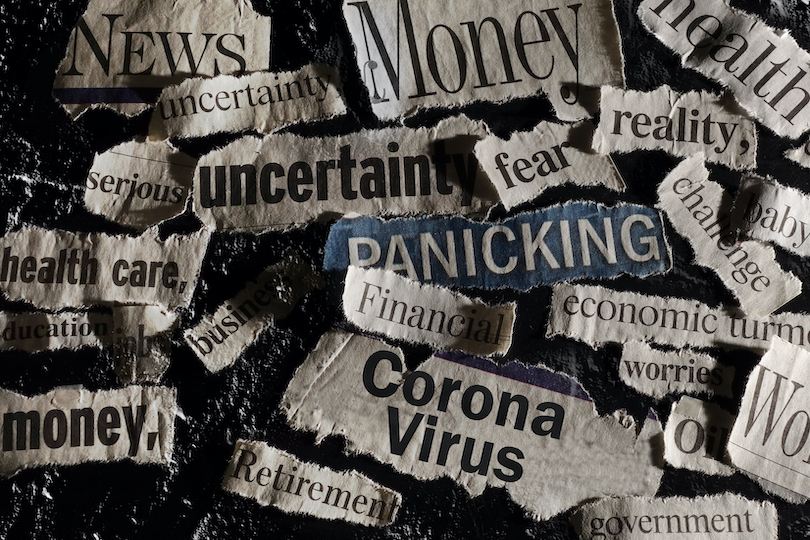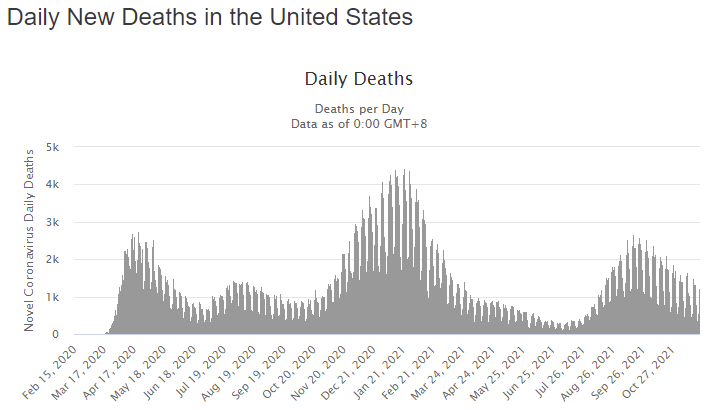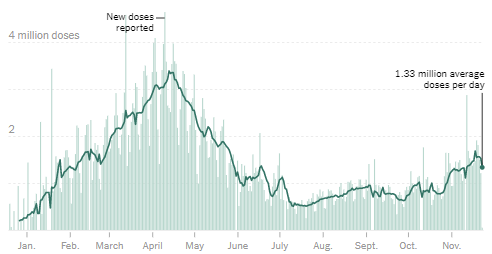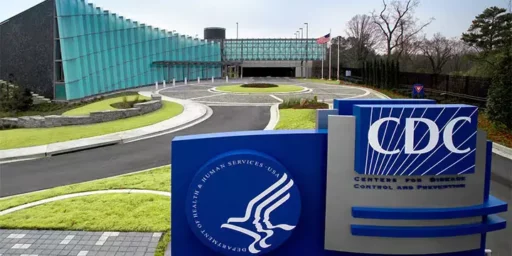More Americans Have Died from Covid this Year than Last
A scary if misleading factoid.

“Despite vaccines, the U.S. has lost more lives to Covid this year than last,” NYT reports.
Headlines like that, alas, will only serve to feed conspiracy theories about the vaccine. A well-educated but older friend from my Army days recently posted an article, translated from the German, from a medical journal claiming that countries with high vaccination rates have higher excess deaths than those without, thus demonstrating that the vaccines are killing people in droves.
According to the NYT report,
This was supposed to be the year vaccines brought the pandemic under control. Instead, more people in the United States have died from Covid-19 this year than died last year, before vaccines were available.
As of Tuesday, the Centers for Disease Control and Prevention had recorded 386,233 deaths involving Covid-19 in 2021, compared with 385,343 in 2020. The final number for this year will be higher, not only because there is more than a month left but because it takes time for local agencies to report deaths to the C.D.C.
Covid-19 has also accounted for a higher percentage of U.S. deaths this year than it did last year: about 13 percent compared with 11 percent.
Experts say the higher death toll is a result of a confluence of factors: most crucially lower-than-needed vaccination rates, but also the relaxation of everyday precautions, like masks and social distancing, and the rise of the highly contagious Delta variant.
Essentially, public health experts said, many Americans are behaving as though Covid-19 is now a manageable, endemic disease rather than a crisis — a transition that will happen eventually but has not happened yet.
Yet many are also refusing to get vaccinated in the numbers required to make that transition to what scientists call “endemicity,” which would mean the virus would still circulate at a lower level with periodic increases and decreases, but not spike in the devastating cycles that have characterized the pandemic. Just 59 percent of Americans are fully vaccinated, the lowest rate of any Group of 7 nation.
“We have the very unfortunate situation of not a high level of vaccine coverage and basically, in most places, a return to normal behaviors that put people at greater risk of coming in contact with the virus,” said Jennifer Nuzzo, an epidemiologist and senior scholar at the Johns Hopkins Center for Health Security. “If you take no protections whatsoever, you have a virus that is capable of moving faster and you have dangerous gaps in immunity, that adds up to, unfortunately, a lot of continued serious illness and deaths.”
There’s no doubt that refusal of people to get the vaccine is a huge problem. And, anecdotally, while people are wearing masks in these parts about as well as they were a year ago—which is to say, most people seem to be doing so with an incredibly high percentage of them doing so incorrectly—people are way, way more likely to be out and about than they were.
But the “more people in the United States have died from Covid-19 this year than died last year, before vaccines were available” juxtaposition is really more noise than light. Look at the daily COVID deaths in the US:

The disease really didn’t start spreading here in earnest until the spring of 2020 and the peak period of deaths stretched well into 2021. Thus, 2020 and 2021 are not comparable or even distinct periods for useful comparison.
Similarly, it’s not as though vaccines were magically available to all on January 1. Eligibility was extremely limited in the early weeks and we didn’t have the supply to get shots to everyone eligible for quite some time. As a Defense Department employee who was also a front-line worker in my capacity as a professor, I was eligible earlier than most and didn’t get my first shot until early March and my second until March 31; I thus wasn’t “fully vaccinated” until mid-April. My stepchildren, who were in their teens and early 20s, weren’t eligible until considerably later. My 12-year-old wasn’t eligible until June. My 10-year-old just became eligible this month. And those under 5 still aren’t. So the “despite vaccines being available” device is rather misleading.

Regardless, we seem to be pretty close to peak adult vaccination. We’re seeing everyone from football coaches and actors making millions of dollars a year to United States military personnel ostensibly prepared to put their lives on the line in the service of their country losing their jobs rather than comply with vaccine mandates. We’re moving to a society where most of us are vaccinated—and dutifully getting our boosters—but a sizable minority are simply not going to do it.






The trends vary pretty widely depending where you are. Currently Maricopa and AZ are showing pretty bad trends. I expect a lot more holiday travel and attendance at Thanksgiving dinners and Christmas parties this year than last, people are just tired of COVID restrictions.
NYT linkies:
https://www.nytimes.com/interactive/2021/us/maricopa-arizona-covid-cases.html?searchResultPosition=1
https://www.nytimes.com/interactive/2021/us/covid-cases.html?pageType=LegacyCollection&collectionName=Maps+and+Trackers&label=Maps+and+Trackers&module=hub_Band®ion=inline&template=storyline_band_recirc
The Delta variant and the inability of many of the public to adapt behaviors in response to its increased infectivity are the major culprits.
Here’s what I’m wondering: is the Delta variant more deadly to the unvaccinated then the original variant? We know it is more transmissible but does it also have a higher mortality rate? Somewhere between 1 in 100 to 1 in 200 of those who got the original variant died. Is it the same for delta amongst the unvaccinated? I haven’t seen any real analysis of this.
@MarkedMan:
I haven’t either but honestly wonder how we’d know. That is, the original wave took out a lot of the most vulnerable population (the elderly with comorbidities, nursing home residents) and we’re not only, generally speaking, no longer dealing with flooded ICUs but we’ve had almost two years of experience treating Covid patients. So, it would be possible for this variant to be far deadlier in a biological sense and yet not be as deadly in impact.
@James Joyner: Those are really good points. One of the things about those initial waves in the major metropolitan areas was that we had no idea how to treat. We were doing some of the exactly wrong things, especially in how we ventilated. I’m not saying the treatment was killing people, as they would have died without intervention, but the treatment even four months later was much more effective, even without the drugs.
There will be thousands upon thousands of PhD thesis that come out of this mess…
Invariably the attempt to compare years has a subtext of comparing Biden to Trump.
As James mentions, there were about 7 months of big death numbers during 2020 as the disease took hold in 2020 due to breathtakingly poor management of the outbreak. 2021, of course, has completed essentially 11 months, so far.
January of 2021 was a particularly awful month for COVID, so my guess is that if you move the date to January 20th, the numbers flatten out considerably between administrations.
One of Niven’s Laws is that no method works if it’s not used. Vaccines haven’t contained the spread because the vaccination rate is abysmally low.
The rest is what I’ve been saying for months: let your guard down, and SARS-CoV-2 will spread unchecked. I’d say the one downside of the vaccines was a letting down of our guard, officially and informally, once people began to get second doses.
Though it seems counter intuitive, infections increasing while hospitalizations and deaths decrease is evidence of Covid moving from a pandemic stage to endemic. The flu infects a great number of people each year and a small subset is hospitalized and a smaller group dies.
We are returning to the new normal.
@Sleeping Dog: After reading your comment I realized I was a bit confused about what defines something as endemic. According to this Columbia Public Health website excerpt below it doesn’t really have anything to do with disease severity or death rate, but rather predictability, location and relative stability.
@MarkedMan:
My reference to the term, comes from where I’ve seen it used in the press. From what you quoted, it seems that the lay understanding, based on press use, maybe broader than the scientific one.
The flu is seasonal, typically appearing only in the winter, but geographically widespread. Covid appears to be moving to seasonality and geographically more confined. I.E. the times of the year where Covid will be ascendant will be those where people socialize indoors or otherwise are in close proximity to each other.
Like seemingly everything about Covid, it is confusing, in large part because knowledge about it updates nearly daily.
When I see students in the classrooms that I visit who are careless about masking, I interrupt whatever they are doing to remind them that, while the school environment is safer, on average only every other person in Cowlitz County has been vaccinated so they should expend whatever efforts they have available to keep both themselves and their classmates safe. I hope it is helping some, but there’s an old saying about the only thing you can really make people do or be and needing a gun for it.